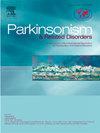基于疾病进展模型的帕金森病患者认知障碍的时间排序
IF 3.1
3区 医学
Q2 CLINICAL NEUROLOGY
引用次数: 0
摘要
导言确定有认知能力下降风险的帕金森病(PD)患者对于加强临床干预至关重要。虽然目前已有几种预测帕金森病认知能力下降的模型,但一种名为疾病进展模型(DPM)的新型机器学习框架提供了一种数据驱动的方法来了解疾病的演变。我们的研究涵盖了一系列生物标记物,包括基线和年度运动、神经认知和神经影像评估。我们采用了一种方法来选择生物标志物的最佳组合,以构建具有卓越预测能力的 DPMs,用于诊断和估计认知功能衰退的转换时间。此外,所提出的从认知障碍到痴呆症的时间轴还被用于探索临床事件,如认知障碍的发生、痴呆症的发展或淀粉样病理。结论神经心理学测量和某些生物标志物,包括脑脊液(CSF)淀粉样蛋白β42(Aβ42)和多巴胺转运体缺陷,可用于预测认知功能衰退和估算从认知功能障碍到痴呆的时间轴,在许多病例中,淀粉样蛋白病理学先于痴呆发病。我们的DPM研究表明,帕金森病患者脑脊液Aβ42和磷酸化tau的情况可能不同于老年患者和阿尔茨海默病患者。本文章由计算机程序翻译,如有差异,请以英文原文为准。
Temporal ordering of cognitive impairment in Parkinson's disease patients based on disease progression models
Introduction
Identifying Parkinson's disease (PD) patients at risk of cognitive decline is crucial for enhancing clinical interventions. While several models predicting cognitive decline in PD exist, a new machine learning framework called disease progression models (DPMs) offers a data-driven approach to understand disease evolution.
Methods
We enrolled 423 PD patients and 196 healthy controls from the Parkinson's Progression Markers Initiative (PPMI). Our study encompassed a range of biomarkers, including motor, neurocognitive, and neuroimaging evaluations at baseline and annually. A methodology was employed to select optimal combinations of biomarkers for constructing DPMs with superior predictive capabilities for both diagnosing and estimating conversion times toward cognitive decline.
Results
At baseline, the approach showed excellent performance in identifying individuals at high risk of cognitive decline within the first five years. Furthermore, the proposed timeline from cognitive impairment to dementia was also used to explore clinical events such as the onset of cognitive impairment, the development of dementia or amyloid pathology. The presence of amyloid pathology did not alter the progression of cognitive impairment among PD patients.
Conclusions
Neuropsychological measures and certain biomarkers, including cerebrospinal fluid (CSF) amyloid beta 42 (Aβ42) and dopamine transporter deficits, can be used to predict cognitive decline and estimate a timeline from cognitive impairment to dementia, with amyloid pathology preceding the onset of dementia in many cases. Our DPMs suggested that the profiles of CSF Aβ42 and phosphorylated tau in PD patients may differ from those in aging patients and those with Alzheimer's disease.
求助全文
通过发布文献求助,成功后即可免费获取论文全文。
去求助
来源期刊

Parkinsonism & related disorders
医学-临床神经学
CiteScore
6.20
自引率
4.90%
发文量
292
审稿时长
39 days
期刊介绍:
Parkinsonism & Related Disorders publishes the results of basic and clinical research contributing to the understanding, diagnosis and treatment of all neurodegenerative syndromes in which Parkinsonism, Essential Tremor or related movement disorders may be a feature. Regular features will include: Review Articles, Point of View articles, Full-length Articles, Short Communications, Case Reports and Letter to the Editor.
 求助内容:
求助内容: 应助结果提醒方式:
应助结果提醒方式:


